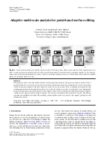Adaptive multi-scale analysis for point-based surface editing
- Georges Nader1
- Gael Guennebaud2
- Nicolas Mellado3
1Université de Lyon, LIRIS UMR 5205 CNRS, France,
2Inria - Univ. Bordeaux - IOGS - CNRS, France,
3University College London, United Kingdom.
22nd Pacific Conference on Computer Graphics and Applications (PG 2014)

Figure 1: Feature-based editing of a detailed point cloud (1.5 millions points). After a prior analysis of the input model (a) to detect, count and extract pertinent scales, the user can edit the geometry in real-time using a graphic equalizer to, for instance, remove the two first level of details (b), remove only the scratches and skin pores (c), or boost them and remove the wrinkles defined at an intermediate scale (d).
Abstract
This paper presents a tool that enables the direct editing of surface features in large point-clouds or meshes. This is made possible by a novel multi-scale analysis of unstructured point-clouds that automatically extracts the number of relevant features together with their respective scale all over the surface. Then, combining this ingredient with an adequate multi-scale decomposition allows us to directly enhance or reduce each feature in an independent manner. Our feature extraction is based on the analysis of the scale-variations of locally fitted surface primitives combined with unsupervised learning techniques. Our tool may be applied either globally or locally, and millions of points are handled in real-time. The resulting system enables users to accurately edit complex geometries with minimal interaction.
Bibtex
@article{CGF33-7:171-179:2014,
journal = {Computer Graphics Forum},
title = {{Adaptive Multi-scale Analysis for Point-based Surface Editing}},
author = {Georges Nader and Gael Guennebaud and Nicolas Mellado },
pages = {171-179},
volume= {33},
number= {7},
year = {2014},
URL = {http://diglib.eg.org/EG/CGF/volume33/issue7/v33i7pp171-179.pdf},
DOI = {10.1111/cgf.12485}
}

Paper (10MB)

Slides (PPTX, videos embedded - 68MB)



